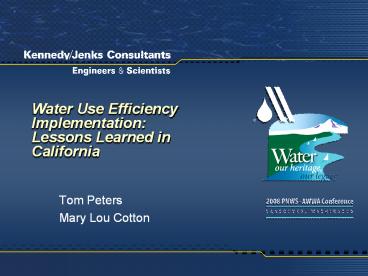Water Use Efficiency Implementation: Lessons Learned in California - PowerPoint PPT Presentation
Title:
Water Use Efficiency Implementation: Lessons Learned in California
Description:
Title: No Slide Title Author: Catherine Lukancic Heanue Last modified by: Judi Ranton Created Date: 10/15/1997 6:24:14 PM Document presentation format – PowerPoint PPT presentation
Number of Views:95
Avg rating:3.0/5.0
Title: Water Use Efficiency Implementation: Lessons Learned in California
1
Water Use Efficiency ImplementationLessons
Learned in California
- Tom Peters
- Mary Lou Cotton
2
Overview/History
- MOU Regarding Urban Water Conservation in
California - Initiated in 1991 (during last major drought)
- Agreement between water suppliers,
environmental/public interest groups, consulting
firms and other interested parties California
Urban Water Conservation Council (Kennedy/Jenks
is a member) - Instituted Best Management Practices (BMPs)
- Two types of BMPs quantifiable and
non-quantifiable (water savings)
3
Overview/History (Cont.)
- BMPs
- Water survey programs for single-family
residential and multi-family residential
customers (non-quantifiable) - Residential plumbing retrofit (quantifiable)
- System water audits, leak detection and repair
(quantifiable) - Metering with commodity rates for all new
connections and retrofit of existing connections
(quantifiable) - Large landscape conservation programs and
incentives (quantifiable)
4
Overview/History (Cont.)
- BMPs (Cont.)
- High-efficiency clothes washing machine financial
incentive programs (quantifiable) - Public information programs (non-quantifiable)
- School education programs (non-quantifiable)
- Conservation programs for commercial, industrial,
and institutional (CII) accounts (quantifiable) - Wholesale agency assistance programs
(non-quantifiable)
5
Overview/History (Cont.)
- BMPs (Cont.)
- Retail conservation pricing (quantifiable)
- Water Conservation Coordinator (non-quantifiable)
- Water waste prohibition (non- quantifiable)
- Residential ULFT replacement programs
(quantifiable)
6
Observed Trends
- BMPs have worked well for about 17 years, but
recent events are driving future conservation
efficiency programs in California - Many conservation programs have relied heavily
(or only) on public outreach and school education - Conservation technologies have diversified
- Technologies are appropriate for some geographic
areas and not for others (diversity)
7
Observed Trends (Cont.)
- CUWCC is in the midst of a major revision of the
MOU and BMPs in response to these various drivers - Lesson Learned Emphasis on increased flexibility
for water agencies to design savings-based
conservation programs, rather than the
proscriptive widget counting approach used
since 1991
8
(No Transcript)
9
(No Transcript)
10
Observed Trends (Cont.)
- Analysis demonstrates the heavy focus that
California water agencies have placed on
residential indoor devices. Landscape and CII
programs have not yet matched these efforts. - However, recent efforts in landscape and CII
sectors have been increasing as efforts in indoor
residential programs have begun to decrease. - Lesson Learned Programs like ULFT replacements
are nearing saturation, plus passive savings from
changes to State plumbing code have started to
accumulate.
11
Overview/Drivers
- California facing new and constant water
shortages - Natural/Hydrologic Colorado River, Sierra Nevada
(global warming-related) - Regulatory/Legal Endangered Species Act, Court
Decisions - Increasing demands on infrastructure
- State Water Project (major MI supplier) nearly
50 years old, serves a larger population than
expected - Continuing energy crisis
- Increasing legislative focus on conservation
- State Urban Water Management Planning Act
requirements for description of progress in
conservation activities required to qualify for
State grant funding
12
Overview/Drivers (Cont.)
- Water conservation (water use efficiency)
policies, planning, technologies and practices
are evolving rapidly - Many water agencies are promoting comprehensive
long term water use efficiency planning
Conservation Master Plans - Moving from a voluntary to a near-mandatory
model recent State legislation
13
Overview/Drivers (Cont.)
- Continued legislative focus as California
wrestles with increased population and decreased
water supplies current session contains at least
four water conservation-related bills - Requirements for all new residential and
commercial development building standards - Requirements for energy conservation programs to
include a water conservation component, partner
with water agencies - Allocation-based rate structures guidance
- Requirements for a 20 gpcd reduction in overall
State water demand, and individual agency
reductions - in addition to requirements of bills chaptered
in last two sessions
14
Impacts on Utilities
- Water conservation is changing from
behavior-based to hardware-based - Lesson Learned Hardware-based measures require
more sophisticated technical analysis - Cost-effectiveness
- Rate structure/pricing evaluations
- Service area/customer sector saturation levels
analysis - Industrial process evaluation
- Landscape conservation techniques/equipment
15
Impacts on Utilities (Cont.)
- Utility conservation staff often not technical
staff - Technical staff may not be available for or
inclined toward non-capital project work - Increased up-front staff costs for
pre-implementation analysis - Implementation of measures more expensive as
conservation programs get more aggressive
16
Summary
- As water supplies in the West become more
limited, more and more water agencies will be
looking for conservation potential in all sectors - Flexibility in program components is needed to
reflect differences in water agency service area
characteristics - Low-hanging fruit programs, especially those
associated with plumbing code changes and device
standards, are those that should be implemented
first least cost for highest savings - Rate structure evaluation, submetering,
commercial/ industrial processes and uses,
cooling retrofits and landscape sector will
provide greatest savings, but will require more
rigorous analysis and increased utility
commitments
17
Questions?































